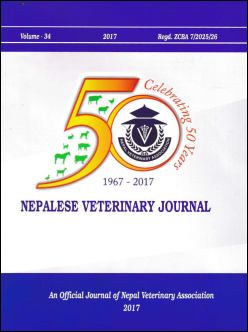Effect of Breed and Gender on Hematological Parameters and Some Serum Biochemical Profiles of Apparently Healthy indigenous Sheep of Nepal
DOI:
https://doi.org/10.3126/nvj.v34i0.22906Keywords:
Sheep, Nepalese breed, hematological parameters, serum biochemical indicesAbstract
This research was conducted to investigate the effect of some factors such as breed and sex on biochemical and serum parameters as well as to establish normal physiological reference values for indigenous breed of sheep of Nepal. Blood sample were collected from 25 apparently healthy sheep (11 males and 14 females) from on station flock at Khumaltar, Nepal Agriculture Research Council (NARC) were used. In case of serum biochemical parameters, overall LS mean for total Protein (TP) was less than physiological range while Albumin (Alb) was recorded higher than normal physiological range. The breed differences were observed in TP where Lampuchhre sheep (lowland sheep) showed the lower value than hill sheep breeds (Baruwal and Kage sheep) taken in the study. The same breed exhibited gender variation in the same parameter with values in males were significantly higher (P<0.05) than females. Comparing LS Mean for Alb and Phosphrous (P) for Nepalese sheep, value recorded for females were found to be significantly higher P (<0.05) than males in case of serum Alb while serum P was significantly lower (P<0.05) in females. For RBC indices, Nepalese sheep exhibited higher Mean Corpuscular Haemoglobin Concentration (MCHC) was higher than normal physiological range. LYM and NE value was significantly higher in Kage breed in comparison to Lampuchhre and Baruwal. The highly significant gender variation for Mean Corpuscular Volume (MCV) (P<0.01) and Mean Corpuscular Hemoglobin MCH (P<0.05) where female showed the higher value than males. The result of the preliminary study revealed the breed and sex variation in case of hematological and biochemical indices Further research with more number of samples is warranted for concrete information which could be used to monitor animal health status to improve the management and conservation of these breeds.
Downloads
Downloads
Published
How to Cite
Issue
Section
License
© Nepal Veterinary Association




